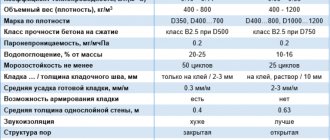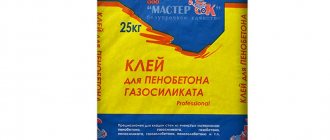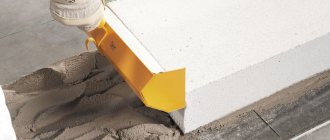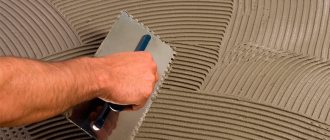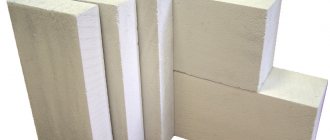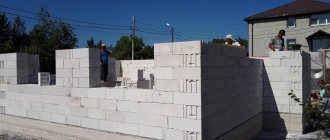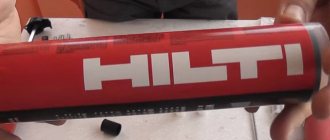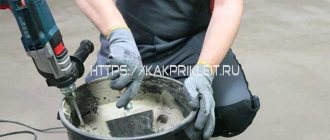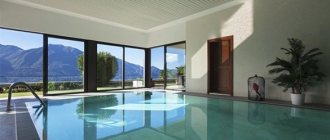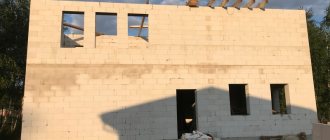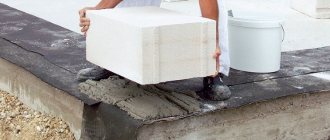Adhesive for cellular concrete is a modern material that is increasingly used in laying foam and aerated concrete instead of the usual cement mortar. The feasibility of using special glue is explained by its excellent adhesive properties, ensuring joint strength, increasing the positive characteristics of cellular concrete and reducing the impact of its shortcomings on the quality of the building.
Due to the many advantages in modern construction, adhesives for cellular concrete are actively used in the construction of buildings of various types and purposes, guaranteeing excellent quality of construction, reliability and increased service life.
Assembly adhesive for cellular concrete blocks
The cost of assembly adhesive is quite high, but it is fully paid for due to the simplicity and speed of installation, and the high quality of the connection. A cheap cement-sand mortar cannot guarantee all the properties of the connection of gas and foam concrete that a special assembly adhesive provides.
Mounting adhesive for cellular concrete is a dry mixture that consists of sand, a special binder and special additives, usually supplied in a volume of 25 kg (Dauer Block, SCANMIX KLADKA, Ceresit, etc.). Composition of the mixture: cement, high-quality quartz sand, high-quality mineral and polymer additives. The cement used to create the mixture is usually M500, the sand must be of very good quality, the composition and features of additional additives are determined by the operating conditions and the necessary properties.
Blocks made of cellular concrete have a high level of heat conservation, so the possibility of reducing cold bridges in masonry is especially relevant. The glue is laid in a thin layer; provided the blocks have good geometry and evenness, the masonry turns out clear and with minimal cold bridges, which has a positive effect on the operational characteristics of the building.
Modern manufacturers offer a variety of glue brands, which may differ in certain properties - YTONG adhesive mixture, Dauer Block, Hercules, etc. (you can find it not only in Moscow, but in any provincial hardware store).
All types of glue mix well and quickly, help speed up and simplify the process of installing blocks, demonstrate excellent ductility, resistance to various influences and tear strength. You can work with glue in any weather (provided you select the appropriate composition).
One way or another, glue for cellular concrete blocks today is an economically viable option that provides the maximum number of advantages and practically no disadvantages.
What tools and materials may be needed
Laying aerated concrete blocks is a construction and installation work that requires special knowledge and skills. Despite its apparent simplicity, working with blocks requires special knowledge and skills. The devil is in the details!
To perform masonry work during the construction of load-bearing walls, you need:
- Construction Materials:
- aerated concrete blocks;
roll waterproofing (for example, hydroisol );
- mounting adhesive solution.
- Tools and equipment:
- electric mixer or drill with a mixing attachment;
- spatula 6-8mm;
- rubber hammer (mallet), grater for leveling;
- electric grinder;
- building level, tape measure, concrete saw.
- wall chaser
The quantity of materials is indicated in the estimate calculated on the basis of the project.
How to lay aerated concrete blocks on a mortar: step-by-step instructions
Masonry work begins with the preparation of the construction site. is laid on the strip or slab foundation . Using a laser level and a metal tape measure, the highest point on the foundation is determined. Masonry begins from this area. to the waterproofing and we begin laying gas blocks. The first gas block is being laid. Next, we also lay blocks in all other internal and external corners, controlling the horizontal level with the first block, diagonal and linear dimensions according to the project. Masonry work is carried out in the following sequence:
- Applying markings (ordering) of future walls, window, doorways, ceilings.
- The laying of the first row of blocks is controlled by the building level, then we control the laying... of each row!
- All rows are laid out along the cord with control of possible sagging. The solution is applied with a notched trowel and spread onto the block in one direction - parallel to the masonry! The thickness of the glue layer is 1-3 mm. In winter, before applying the mixture, the gas block is cleared of snow and ice.
- The position of the block is adjusted using a rubber mallet until the mounting mortar sets.
- If it is necessary to add blocks, they are cut with a hacksaw. The cutting areas are processed with a grater .
- When laying a row is completed, the surface of the blocks, especially at the joints, is leveled with a trowel to avoid cracking of the material as a result of stress.
- The rest of the walls are laid out in the same way. Defects are cleaned using a grinder .
Before starting construction, you need to decide how to lay the gas block on the solution. To do this, before starting to lay each row, the blocks are laid out dry, without glue, to determine high-quality connections with the internal walls and form additional blocks of sufficient size.
Advantages of use
- Rapid strength gain due to special composition
- The thickness of the connecting layer is only 3-4 millimeters
- Low thermal conductivity of seams in blocks
- Resistance to biological influences - various microorganisms
- Resistance to sudden temperature changes - even in difficult conditions, the masonry will not crack or deform
- Cost-effective - the total consumption of assembly adhesive is 3-5 times less when compared with a solution
- Significant reduction in time and simplification of the installation process
Tool for applying glue to aerated concrete
The tools used for laying aerated concrete blocks use quite a few simple devices. The main ones are:
- trowel,
- notched spatula,
- toothed bucket,
- carriage.
It’s worth saying more about the carriage. It belongs to professional tools, and the purchase of this device is justified if there are large and constant volumes of work. The carriage allows you to maintain a constant thickness of the seam and simplifies the application of glue due to a special container.
What to use in winter
In winter, frost-resistant assembly adhesive is usually used to connect blocks of cellular concrete. Special antifreeze additives are introduced into it; they allow you to preserve all the properties of the solution even at sub-zero temperatures. Work can be carried out at low temperatures down to -10C, but carefully ensure that the temperature of the material itself is above zero.
Winter adhesive compositions - properties:
- Saving characteristics when minus
- High level of ductility
- After cooking the color turns gray
- No joints between elements, which allows you to retain heat
- Good resistance to moisture
Assembly adhesive for installation at sub-zero temperatures is stored in heated rooms, diluted with warm water (it is better to heat to about +60C). You need to work quickly with the prepared solution in winter, since the mixture loses all its positive properties within 30 minutes.
Types of glue
The construction process is an almost year-round affair and you never know in what weather it will be carried out, be it a hot summer or a snowy winter. Of course, in most cases, many builders and construction companies try to plan their work, but if you do not want it to stand still during a certain season, then manufacturers of building materials and in particular adhesive compositions have provided the market with two types: summer and winter.
Summer line-up:
The peculiarity of this mixture is white cement, and it sets within two hours after adding water, so you need to carefully monitor this. Naturally, this glue is used during construction in the warm season, and the operating temperature is considered to be from 5 to 30 degrees Celsius.
Winter composition:
Here we can judge from the name that this mixture is used to work in colder weather, with temperatures ranging from +5 to -10 degrees Celsius on average. Essentially, this mixture has the same composition, but in addition to the main components, it also contains anti-frost agents. You need to dilute the mixture with water, which according to the instructions should be heated to 60 degrees, and this mixture hardens in just 30-40 minutes, so it is best to mix the glue in small portions and work quickly.
Application technique
The special masonry mixture for aerated concrete blocks is quite easy to work with. The entire procedure is divided into several main stages; the technology must be followed carefully, which will ensure high quality masonry and allow you to experience all the advantages of the material.
The main stages of working with assembly adhesive:
- Proper preparation of the base - the surface must be dry, free of dirt and dust, any stains of oil or other substances. All roughness and defects are removed, the surface can be leveled with a solution at least a day before starting work with assembly adhesive for cellular concrete.
- Preparing the glue for use - the dry composition is diluted with warm water in a ratio of 1:5 (water and glue, respectively), stirred thoroughly to remove lumps. Allow the glue to stand for 5 minutes, then gently mix again. The finished composition for laying blocks is used within 2 hours after mixing.
- Direct installation of cellular blocks - the solution is placed on the surface with a special box or spatula, leveled with a notched trowel. The blocks are glued with slight pressure; the connection will acquire sufficient strength within 20 minutes, so the position of the block must be corrected and leveled in the first 10 minutes after laying. Complete hardening occurs after different times depending on the composition of the specific adhesive, the level of humidity and temperature in the room, and the thickness of the layer, but is usually completed within 24 hours.
Preparation of mortar for aerated concrete
The technology for preparing an adhesive solution with your own hands is quite simple. Water is poured into the preparation container in the required volume and the dry mixture is gradually poured in with constant stirring. The required proportions can be found on the packaging.
Mixing the solution can be done manually, but the most convenient option is to use a special drill attachment. It is necessary to achieve complete homogeneity of the mass. Next, the finished solution is allowed to stand for about 10 minutes and mixed again.
Kneading must be done in small portions, since the glue sets quickly enough. During operation, the mass is periodically mixed, while adding water to the finished solution is strictly prohibited. The finished solution begins to be applied to the second row, since the sand mixture is laid on the first to achieve initial leveling.
Mixture consumption
Construction adhesive for cellular concrete is quite economical; the required volume is determined in accordance with the quality and size of the blocks. If the blocks are not of very good quality, poorly cleaned, with chips and large deformations, more glue will be needed. Blocks with ideal geometry are laid faster and with less consumption. On average, about 20-30 kilograms of dry mixture will be needed per cubic meter of masonry.
What affects the consumption of assembly adhesive:
- Brand - different compositions may require different consumption, which is explained by their properties. But the difference is usually not very large compared to the standard value.
- The thickness of the masonry layer - usually the adhesive is applied in a layer of 0.5-3 millimeters; this parameter largely depends on the geometry of the cellular concrete blocks.
- The professionalism of the master - the more carefully and accurately he works, the less glue is used.
- The evenness of the building's base and weather conditions also largely affect consumption.
Masonry process
First of all, it is worth noting that when working with foam blocks, the first row is always placed on cement mortar, in order to avoid various (certainly possible) unevenness of the foundation, and glue is used from the second row.
During the laying process, if you are working with ordinary, standard blocks, then glue must be applied not only to the horizontal edges, but also to the vertical ones. In the case of using blocks with a tongue-and-groove connection, applying an adhesive solution to the vertical ends is optional, if not necessary.
Naturally, it is also best to prepare the blocks themselves immediately before laying, cleaning them from dust and possible fine dirt so that the glue is applied to an absolutely clean surface.
Adhesive for cellular concrete: is it needed at all and which one to buy?
Construction adhesive for foam and aerated concrete is the most appropriate choice, even despite the relatively high cost. The ability to significantly speed up and simplify the installation process and provide the masonry with higher strength characteristics in the future has a positive effect on the overall costs and quality of operation of the building.
Why is it preferable to use adhesive instead of cement mortar?
Cement mortar is the most common option for laying any blocks, but modern mounting adhesive compositions provide many more advantages and have fewer disadvantages. First of all, we are talking about heat conservation (and this is the main advantage of cellular concrete) and the elimination of cold bridges, which significantly increases the thermal insulation properties and makes it possible to build walls without additional insulation.
It is also important that special additives are introduced into the assembly adhesive for cellular concrete to reduce the water absorption coefficient.
This is the main disadvantage of cellular blocks - they strongly absorb moisture, and when the seams remain dry, they can crack. The adhesive joint does not allow the cellular concrete to become saturated with moisture and is resistant to water.
Construction adhesive demonstrates much higher strength compared to conventional cement mortar, which is explained by its preparation from the M500 cement grade and the introduction of special additives into the composition. The masonry quickly gains strength and becomes capable of withstanding considerable loads.
It is worth noting the ease of installation using mounting adhesive for cellular concrete. The glue is easy to prepare, you can work with it simply and quickly, there is no need to use additional equipment or tools. There is no need to wait a long time for the masonry to gain strength; the quality of the seams eliminates the possibility of additional repairs or installation.
Flaws
As for the disadvantages, there are none in terms of direct use of the adhesive mixture.
But the cost of these compositions is still relatively high, so at this stage they are mainly used for small buildings. However, despite the fact that cement mortar can be much cheaper, with the correct geometry and accurate calculations you will most likely be able to save a lot of money, since with the above advantages and the high plasticity of the mixture, glue for masonry can use up to six times less than cement mortar . And here you don’t need to be a mathematician to calculate the difference in costs, so this disadvantage is also very ambiguous.
How to choose adhesive for cellular concrete
When choosing an adhesive, you need to take into account the characteristics of the cellular material that will be used in the work.
It is also necessary to determine the basic requirements for seams and installation and operating conditions: the adhesive may have increased strength, frost-resistant, moisture-resistant and other characteristics.
There are additives to increase thermal insulation and sound insulation properties. You can choose glue with increased ductility or compositions with higher adhesion and certain requirements for preparation and installation.
Advantages and disadvantages of cement mortar
Cement mortar is a popular material for construction work; it is easy to manufacture and has low cost. All work can be done with your own hands; no special skills are required.
Composition of the sand-cement mixture:
- Portland cement m400;
- Quartz sand;
- Water;
- Slaked lime – improves the thermal insulation of the structure;
- Foaming additives - they help increase thermal insulation performance, but negatively affect the strength of the solution;
- Plasticizers - increase the elasticity of the mixture, reduce the shrinkage of the solution, increase strength and longevity.
Is it possible to lay foam blocks on cement mortar, definitely, but to improve the properties it is better to use mixtures that contain additional additives. You can buy them at a hardware store, the price is quite reasonable.
Advantages of laying foam blocks on cement mortar:
- Strength;
- Low price;
- Availability of materials;
- Making it yourself;
- Durability;
- You can even out unevenness due to the thickness of the seam.
The main disadvantages of the cement-sand mixture:
- The emergence of “Bridges” of cold;
- Low thermal insulation of walls;
- Poor resistance to moisture.
Review of popular adhesives
Modern manufacturers offer a large selection of assembly adhesive compositions for cellular concrete. You need to choose according to your requirements and properties, trusting the best brands that guarantee high quality products and compliance with the stated parameters.
Hercules
The adhesive is used for laying cellular concrete and is supplied dry in a sealed container weighing 25 kilograms. Suitable for construction inside and outside the building, as well as for leveling minimal defects of a maximum size of 10 millimeters.
The composition of the adhesive includes: cement, sand, various powder polymers, complete absence of harmful toxic compounds. Assembly adhesive demonstrates a high level of strength, guarantees the reliability of the masonry and good thermal insulation. The solid seam is not afraid of precipitation, subzero temperatures, or humidity.
Rusean
Assembly adhesive is intended for interior and exterior work and guarantees quick connection of any porous materials. The composition includes M500 cement, quartz sand, various types of mineral additives. The mixture is plastic, with good adhesion, the seam can withstand exposure to moisture, low and high temperatures.
Volma block
The mixture is created from cement, fractionated sand, and high-quality additives. The composition is elastic, dense, durable. It is applied in a thin layer, which increases the thermal insulation characteristics of the masonry. Not afraid of low temperatures, suitable for all types of cellular concrete.
Properties and composition of adhesive for gas silicate blocks
The composition of gas silicate adhesive includes the following components:
- binder base in the form of high-quality Portland cement;
- fine sand;
- polymer additives;
- modifying inclusions.
The polymer components are designed to ensure the plasticity of the mass and improve the adhesive properties of the solution. Modifiers help retain internal moisture, which protects the seams from cracking.
High surface adhesion properties are among the key features of adhesive compositions. They also note the low level of thermal conductivity of the product, which is due to the absence of voids in the seams.
Masonry mixtures for the first row of aerated concrete blocks
The bottom row of foam concrete should be placed on the CPR. There are two reasons to do this:
- The first row of aerated concrete masonry, according to STO NAAG 3.1-2013, must be protected from capillary moisture. To do this, a waterproofing film should be installed between the surfaces of the foundation and foam concrete.
- In addition, the masonry must be fully supported by the supporting structure to ensure complete load distribution
It is recommended to use adhesives only if the difference in elevation between the highest and lowest points exceeds 5 mm. In practice, such grounds do not occur.
What to put gas blocks on?
Recently, there has been an active discussion about what to lay walls from aerated concrete blocks on. Let's compare the main options.
Three main options
In construction, three methods of laying aerated concrete are used: with cement-sand mortar (CSM), with adhesive for laying cellular concrete, and with foam adhesive.
- CPS
is a regular mortar of cement and sand. Sometimes you can come across the opinion that it is impossible to lay gas blocks on it due to excess moisture, but this is a misconception. Aerated concrete arrives at a construction site in a fairly wet state and it is quite difficult to avoid additional moisture. If you follow the deadlines for drying the blocks before finishing and insulation begins, the aerated block will reach a humidity equilibrium with the environment (4 - 5% by weight).
The humidity of aerated concrete after processing in an autoclave can reach 50%. During the construction process, the porous material can be additionally moistened. Read about the humidity of gas blocks in the article on the channel (link at the end).
- Adhesive for aerated concrete masonry
is made on the basis of cement and contains plasticizers that increase its plasticity. In its composition and installation method, this masonry mixture is similar to tile adhesive.
- Adhesive foam
is fundamentally different from the two previous mixtures. It is not based on a mineral binder. The main component is polyurethane foam, which is compressed in a cylinder. After application, the composition enters into a chemical reaction with moisture and air and begins to harden. As the foam hardens, it fills the masonry joint and holds the blocks together.
Which is easier to work with?
In this matter, the advantage will be with adhesive foam. Application does not require special mason skills. The foam does not need to be pre-mixed, which means the amount of auxiliary work is reduced.
The most difficult from the point of view of work are cement-sand mixtures, since they require a fairly thick seam, which should not “walk”.
- DSP
is difficult to work with if a person does not have professional mason skills. - Mineral glue
is easier to work with than DSP, but you can’t do it without masonry experience. - Foam Adhesive
- No masonry experience required, so good for DIYers.
Possibility of thin-layer masonry
Seams in masonry are the most problematic areas: they are the main “cold bridges”; a thick seam disrupts the uniformity of the wall structure. Mechanical stress may occur at the seams, which leads to the appearance of cracks.
The presence of cracks is not always the result of defects. The length and opening are standardized in the relevant documents. The appearance of cracks is the result of shrinkage of a stone house. Some measures, such as reinforcement, help reduce the opening of cracks, but do not prevent their occurrence.
- Masonry on DSP
- minimum seam size 10 - 12 mm. - Masonry with mineral adhesive
- minimum size 2 mm - Laying on adhesive foam
- less than 2 mm.
Requirements for block geometry
The geometry of blocks is deviations from verticals and horizontals. Curved blocks make it difficult to form straight seams. At the joints of two skewed blocks, “teeth” appear that must be cut off with a grater.
Based on geometry, blocks are divided into categories I and II. When working with the second category, the amount of preparatory work on leveling the products increases.
- Masonry on DSP
- you can use blocks of category II; a thick seam allows you to compensate for curvature. - Masonry with mineral glue
- you can compensate for minor unevenness by increasing the seam to 3 - 4 mm, but this does not exclude preliminary preparation with a float. - Adhesive foam
- difficulties may arise with blocks of category II; you will need to work a lot with a grater. This method of laying is convenient if the geometry of the blocks is close to ideal.
Which is stronger?
It is customary to judge strength by the brand of mortar, but it is important for us to find out what strength the mortar provides not on its own, but in combination with masonry made of aerated blocks. In addition, it is quite problematic to compare mineral solutions by brand with glue.
- The strength of the masonry is affected by the thickness of the seam. When the horizontal seam increases from 10 - 12 mm to 20 mm, the strength decreases by 20%, and to 30 mm - by 30%.
- With a thick seam, increasing the ultimate strength of the mortar increases the strength of the masonry only at low values. And when the ultimate strength is above 20, this parameter has practically no effect. Further, the main influence is the strength of the stone itself.
- The strength of masonry with a thin seam, in principle, does not depend on the strength of the mortar. The only thing that matters here is the strength of the stone. This conclusion was introduced into European standards based on tests.
- In terms of compression resistance, thin-layer masonry is 20-30% superior to CFRP masonry. Elasticity allows the mortar in masonry with a thin seam to absorb pressure even at low loads.
- Masonry with adhesive foam has comparable strength, but the foam itself has low elasticity, so under load it first deforms slightly. This may result in slight shrinkage at low loads.
Which is cheaper?
At first glance, at a price per 1 kg of solution, DSP If you look at the actual consumption, then due to the thickness of the DSP joint it is higher than that of mineral glue (16 - 19 kg/sq.m.).- Mineral glue
- the price for 25 kg will be 250 - 300 rubles. Consumption is 3 - 6 kg/sq.m. (13.8 lm with a block width of 300 mm) - Adhesive foam
- the cost of one cylinder is 400 - 600 rubles. Consumption - 40 - 60 linear meters with a strip diameter of 2 - 3 cm. Manufacturers themselves sometimes indicate that one cylinder corresponds to 50 kg of dry mixture. Accordingly, the price is approximately comparable to the cost of mineral glue.
It must be taken into account that 25 kg bags need to be delivered, and in some cases also lifted to the site. Adhesive foam is more practical in this regard - it can be transported by car, which means delivery costs are kept to a minimum.
Conclusion
Masonry with a thin seam for aerated concrete looks like the most profitable and practical solution. If you plan to carry out the work yourself, then laying on adhesive foam can be considered the most suitable option.
